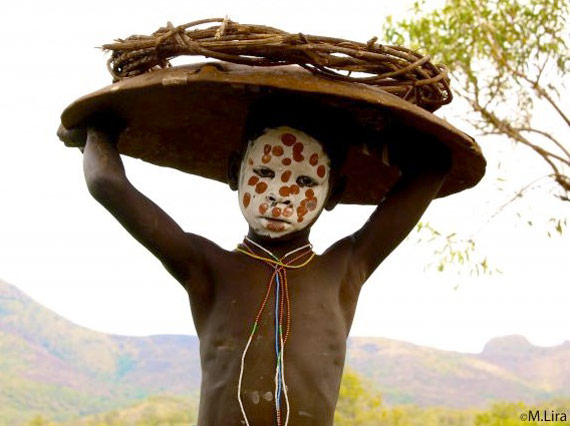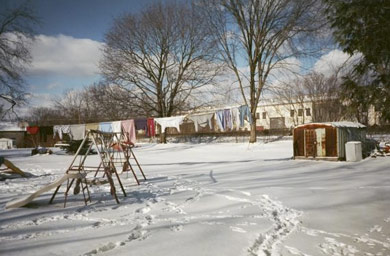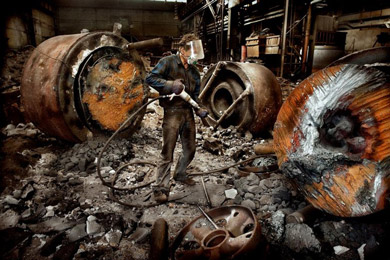|
SPOTLIGHT/July 31, 2011
 | |
Marcos Lira. Surma Boy
|
Tribes of the Omo Valley
Photographs by Marcos Lira
Photographer Marcos Lira visited the remote tribes of the Omo Valley, Ethiopia, in 2010. Their remoteness and inaccessibility has enabled the tribes to resist outside influence. Ethiopia is building a series of hydroelectric dams along the river Omo to develop the country. People in the capital, Addis Ababa, say that the people of the Omo Valley are "uncivilized" and their lack of skills makes it difficult to assimilate them into modern society. However, these tribes have unique rituals that will be lost forever through the effort to develop the land.
Click here to view exhibit.
|
|
 Breaking the Stigma Daniel Padro Centellas
This exhibits aims to bring Acondroplazy, or dwarfism, to the public to break the stigma often associated with this condition. |
 The Place Where I am Not Tina Remiz
A documentary project exploring the dramatic changes that took place in Latvia over the past three years. |
 Dreams Academy Kate Lynch
In 2008 Ercan Tutal opened the Dreams Academy in Istanbul to provide arts training and workshops for the city's disabled and disadvantaged youth. |
 Faces of Salem Salem Multicultural Institute
In the spirit of honoring and shedding light on Salem's rich and expanding cultural mosaic, a team of documentary photographers emerged this year to create the exhibit "Faces of Salem," at the Salem Multicultural Institute's "World Beat Gallery." |
|
|
PEOPLES' CHOICE AWARD:
Ten Years After 9/11: Searching for a 21st Century Landscape
Along the Tracks
Photographs by Sylvia de Swaan
 | |
Photo by Sylvia de Swaan. Winter Laundry, Along the East West Tracks, Whitesboro, NY. 2008. The people have voted. De Swaan's submission to the SDN Call for Entries received the most visits after the first place winner.
|
"Central New York was once a hub of industry -- factories cranked out products for the nation that brought jobs and vibrancy to local cities and towns, now replaced by strip malls and mega stores whose merchandise is manufactured in the sweatshops of distant lands. We live in a fast-changing world. What happens here in our geographic corner is a trickle down from a globe in transition, spinning on its axis -- war, terror, surveillance, pollution, urban decline, land issues, guns and violence come at us through the media and filter through to our own city streets."
Click here to view the exhibit. |
The Un-Gentrified
Photographs by Najib Joe Hakim 
Photo by Najib Joe Hakim. Joe Eadeh, Diner Owner.
These are portraits of people who live and work in the San Francisco neighborhood of Noe Valley. Since 1990, Noe Valley has experienced rapid socio-economic changes led by skyrocketing home values and rents. One result of this change has been the gentrification of the neighborhood evidenced by the influx of hip, tech-saavy professionals, the incessant remodeling and enlarging of old Victorian homes, and the condo-ization of apartments. Like other parts of San Francisco, working class people in Noe Valley are being squeezed out by those who can afford the radioactive real estate prices. But some hold on, protected by strict rent control laws or by the good fortune of already owning their homes.
Click here to view the exhibit. |
Drug Addicts in Athens, Greece
Photographs by Iakovos Hatzistavrou 
Photo by Iakovos Hatzistavrou. Drug addicts on Sofokleous Street in Athens.
"In the last few years, Athens has dramatically changed. The residents complain about the situation in the historical center. Drugs, robberies, and prostitution are on the rise, with a daily manhunt by the police. Greece is dangerously winning the first place in drug use among the countries of Europe."
Click here to view the exhibit. |

Exhibition of Winners of SDN Call for Entries Opens in Brooklyn on August 20

Photograph by Garth Lenz, first place winner of the Call for Entries. SYNCRUDE UPGRADER AND TAR SANDS / Alberta Tar Sands | 2005
Ten Years After Nine Eleven: Searching for
a 21st Century Landscape
August 20-September 16, 2011
powerHouse Arena
37 Main Street, Brooklyn, NY
Reception: Saturday, September 10, 7 - 9 pm
First Place Winner: Garth Lenz, Canada's Tar Sands and the True Cost of Oil
Honorable Mentions: Michael Robinson Chavez, Metamorphosis: Images from the Arab World; Florian BŁttner, Modern Slaves of Dubai; Michael Busse, Unidentified Landscapes.
Judges included Lori Grinker, Ed Kashi, Nina Berman, Fred Ritchin, Glenn Ruga, Tomasz Tomaszewski.
Click here to view complete information about the Call for Entries.
Exhibition of SDN 2010 Call for Entries Opens in Portland, Maine, August 5 
Photograph by Tomasz Tomaszewski, first place winner of 2010 Call for Entries. Labendy Factory, Silesia, Poland. The Salt Institute for Documentary Studies in Portland, Maine will be exhibiting SDN's first Call for Entries on the theme "Crisis and Opportunity: Documenting the Global Recession." August 5 - September 30
Opening reception, Friday, August 5, 5-8 p.m. Photographers include winner Tomasz Tomaszewski (Poland) and honorable mentions Khaled Hasan (Bangladesh), Shiho Fukada (Japan) and Michael McElroy (USA). Judges included Lori Grinker, Ed Kashi, Lucian Perkins, Shahidul Alam, Craig Cohen, and Whitney Johnson. Salt Institute for Documentary Studies
561 Congress Street
Portland, ME 04101
www.salt.edu |
Open Society Institute Announces Moving Walls 19 Photographers The Open Society Foundation's Documentary Photography Project is pleased to announce the photographers included in its Moving Walls 19 exhibition. The exhibition will open to the public on December 1, 2011, in the Foundation's New York City office and move to the Washington, D.C., office in the fall of 2012.
Moving Walls 19 Photographers Read More>> |
Jerome Liebling, Photo League photographer, and educator to many, dies at 87 I was saddened to learn of the death of Jerome Liebling, one of the most important documentary photographers to come out of the immediate post-war experience, and who went on to establish the film, photography, and video program at Hampshire College in Amherst, Massachusetts in 1969. I knew, or knew of, Liebling during the 20 years I spent in western Massachusetts following my graduation from the University of Massachusetts in 1981. There was a loose community of photographers in western Massachusetts, but it was always Liebling whom we considered the most important photographer, and, more than any other, established the credibility of this community. His career spanned a tremendous body of work, sprouting from his two-year tenure with the Photo League beginning in 1947. The Photo League eventually was forced to close in 1951 due to its communist roots at a time during the Cold War when Washington was weeding out Communist sympathizers. The careers of many talented artists were destroyed during this time, but Liebling was never personally charged with being a Communist sympathizer and he went on to establish the photography department at the University of Minnesota in 1949 before he moved to Amherst to do the same for the University of Massachusetts. As the founder of SDN, I hope that Liebling and the body of work that he created can be a beacon for photographers today to appreciate the core and original fascination with photography as a tool to document and explore our world and make wise commentary on both the most personal and the most political relationships. Since Liebling's death, numerous thoughtful and heartfelt obituaries have been written by western Massachusetts newspapers, The New York Times, Hampshire College, and by James Estrin from the New York Times Lens Blog, who studied with Liebling at Hampshire College. I hope his legacy only grows stronger.
|
About SocialDocumentary.net
SocialDocumentary.net is a website for photographers, NGOs, journalists, editors, and students to create and explore documentary exhibits investigating critical issues facing the world today. Recent exhibits have explored oil workers in the Niger River Delta, male sex workers in India, Central American immigrant women during their journey north, and Iraqi and Afghan refugees in Greece.Click here to view all of the exhibits.
Spotlight editor: Glenn Ruga
|
|
|
|
|
|
|